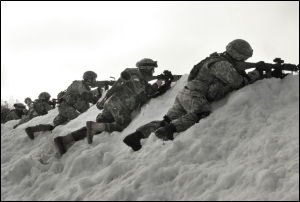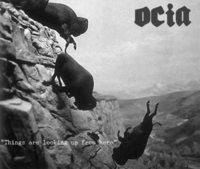Amokolian War
| Amokolian/Ocian War | |||||||||
|---|---|---|---|---|---|---|---|---|---|
 Shirereithan troops besiege La Terre |
|||||||||
|
|||||||||
| Belligerents | |||||||||
| Ashkenatza Antica Babkha Shireroth Hamland National Amokolian Provisional Authority | Ocian Federation | ||||||||
| Imperial Mercenary Empire (from September 16th) | Imperial Mercenary Empire (until September 16th) |
||||||||
| Commanders and leaders | |||||||||
| Pachad Emet ben Mavet Moshe Goltz Szhmuel Astopov Alex Allenby Jess Heimer Malliki Tosha Greg Russell Leo Dine Christopher Octavius Nick Foghorn Kufukhaf Iskander Khan Extreme 007 | Matt Kovac Lord Montague Kolya Radchenko Extreme 007 |
||||||||
The Amokolian War (also known as the Ocian War, War of Amokolian Liberation and by Ocians as the Patriotic War of Liberation from Facsism [sic]), was a military conflict fought between the 1st of September and 7th of October 2009 primarily in Amokolia on the continent of Benacia, but later in Ocian territories on Keltia and Apollonia. The culmination of rising tensions between Ashkenatza and Ocia at the time, it eventually drew in a large number of other micronations and resulted in some important changes to the political atlas of Micras, primarily on Benacia. Belligerents included Ashkenatza, Antica, Shireroth, Hamland, Ocia, the Imperial Mercenary Empire, Babkha and the National Provisional Amokolian Authority, and observer and peacekeeper forces from a number of nations including Batavia and Stormark.
Background
Ashkenatza and Ocia by 2009 had reached an impasse in diplomatic relations with regular belligerent declarations made on a regular basis against eachother by both governments- this hostility believed to originate in Ashkenatzi refusal to enter into full diplomatic relations with Ocia after being cautioned by wary overseas friends and diplomats as to the nature of the Ocian leadership under President Matt Kovac. By summer 2009 tensions had gotten worse due to the Ocian annexation of the formerly independent Kingdom of Amokolia as a member of the Ocian Federation. Ashkenatza, wary of the new Ocian presence to its north, feared for its long-term security and after the Ocian government closed the border between Ashkenatza and Ocia on July 11th, and began to fortify the long border region. Foreign Minister of Ashkenatza Moshe Goltz under the new provisional government of Nohsi Herr Pachad Emet ben Mavet declared war on the Ocian Federation on August 21st in a public announcement in the village of Bozparozbany, White Litovina, his reasons given were as follows:
"the unilateral closure [of the border] is an affront to Ashkenatza's natural dignity which makes normal bilateral diplomacy [with Ocia] impossible. The dangerous and miliaristic streak of unilateralism inherent in the foreign policy of President Kovac makes him a reckless leader who endangers the civil society in which he has been, regretfully, permitted to operate [...] in light of which the Republic of Ashkenatza cannot tolerate the Ocian intrusion into the civilised pantheon of Benacian nations. As such the Republic of Ashkenatza considers it its moral duty to liberate Amokolia from its disastrous decision to enter into a formal union with this dangerous pariah state."
This was communicated in person to President Kovac by the then Nohsi of Ashkenatza, P.E ben Mavet. President Kovac responded by expelling ethnic Ashkenatzim from the Ocian Federation and Ashkenatza petitioned the MCS for a RecWar. On the 1st of September the MCS officially began a RecWar under the Anunia Convention ruleset and that very same day Amokolia erupted in open rebellion against Ocian rule, after several days of open political dissent against Ocia and Ashkenatza's prior recognition of the Amokolian Authority on August 25th. This National Provisional Amokolian Authority, led by former leader and founder of Amokolia Jess Heimer, armed itself and started acts of civil disobedience in the capital of Ocian Amokolia, Anun, and made diplomatic overtures to Ashkenatza to join their struggle. It was henceforth that Ashkenatza, which also had territorial ambitions itself in the region, began to refer to the war as the War of Amokolian Liberation. The Ocians, meanwhile, had begun to refer to it as a war of Liberation against 'Facsism' [sic], a name rejected by every other participant in the conflict who tended to refer to the conflict as either the Ocian War or Amokolian War. Ocian forces had not by September 2009 deployed en masse to Amokolia, and the Ocian military presence there at the start of the conflict were solely border guards and special police units. The Ocian Federation, due to the revolt, therefore did not have de-facto control over large areas of Amokolia for much of the war and would have to deploy troops there during the conflict. By the start of the war it was clear that Ashkenatza would be supported by the Babkhan government of Hesam Jahandar Shahanshah in its war against Ocia (the Babkhan declaration of war given just a day after Ashkenatza's by the Shahanshah, offering 500,000 rials for the head of President Kovac), and with the inclusion of foreign powers such as a declaration of support to Ashkenatza from Universalis it became clear that this war would be far larger than a regional conflict in Benacia.
Invasion of Amokolia
The full diplomatic ramifications of the war had by its very onset become self-evident. Already foreign interest in the deteriorating situation was on the rise and Hamland, later to become an Ashkenatzi military ally, sent peacekeeping forces to Amokolia via Southern Ashkenatza. Ocian commanders such as Matt Kovac, Lord Montague, and Kolya Radchenko were preparing for war in Ocia's home territories on Keltia as leading Ocian minister Matthew Dervin failed to report for duty. Ashkenatzi commanders already starting a pre-planned military operation near Benaciastadt (a former divided city between Tellia, Amokolia, and Ashkenatza) included Pachad Emet ben Mavet, Moshe Goltz, Alex Allenby and Szhmuel Astopov. As per Anunia Convention rules, territorial concessions to be granted to either side in the case of defeat had to be stated by both belligerent parties before the conflict could begin and Ocian intransigence in the matter delayed the official start of the RecWar for several days- Ashkenatza's territorial demands in exchange for aiding the Amokolians in their liberation struggle included the extension of Izaria northwards to the northern coast of Benacia near the city of Cherokee, the transfer of the Benaciastadt salient to Ashkenatzi control, and smaller border rectifications near Zaprogia. Ashkenatza agreed to transfer non-Benacian possessions to Ocia in the event of an Ashkenatzi defeat.
On September 1st Ashkenatza launched Operation Bathsheba's Fecundity. A creeping artillery barrage across Benaciastadt and its rapid encirclement by Goltz's forces on the 1st of September saw the dividing wall between the Ocian and Ashkenatzi sectors of the city demolished and its quick capitualtion. Ocian border guards were quickly overwhelmed whilst Astopov's forces, the 5th and 6th Ashkenatzi divisions, advanced into Western Amokolia from Izaria on the city of Tel-Amok. Air forces controlled by Ben Mavet, Commander-in-Chief of all Ashkenatzi forces, destroyed much of Benaciastat's road and rail infrastructure and sent the city into a 24 hour communications blackout after issuing a statement that all Ashkenatzi airspace was henceforth closed to civilian traffic. General Allenby's Ashkenatzi forces arrived outside the Amokolian city of Veña. These early manouevres were the first ever use of Ashkenatza's indigenously produced military hardware- notably the MPF Ezekiel and Pachad Gringpanser tanks and PSI Helios Airship variants. Goltz's troops, leaving Benaciastadt on the 2nd of September, joined with Allenby's forces in Veña as the Babkhan military commenced a plan for the seizure of Ocian territory in Apollonia, in former Woodstanic territories. The Babkhan Admiral Kufukhaf Iskander Khan set sail for Newport from the Euran port of Susa.
Meanwhile, Shireroth had been watching the situation with some interest as Commander Malliki Tosha of the Elwynnbrigaden quickly mobilised forces along the Amokolian-Shirereithan border in Elwynn. The Shirereithan airforce was placed under a state of alert as Elwynnese Kampfgruppen marched for the Amokolian border. After deliberation, Kaiser Gaelen III declared Shireroth at war with Ocia in Kaiserial decrees #388 and #391, stating that:
"A safe, stable Benacia is paramount to our national security. The last thing we want as a neighbour is a disaffected Amokolia under the rule of the politically unstable Ocia, liable to lash out at little provocation and difficult to trade and cooperate with"
Gaelen III authorised an immediate Shirereithan assault on the Amokolian city of Petersburg which was met without resistance. Tosha was joined by Yardistani veteran admiral Greg Russell, whose 9th Shirereithan Expeditionary Strike Group set sail from Corrigible, Western Absentia, for La Terre, where one of the first true conflicts in the war was emerging. Shirereithan forces marching through Elwynn had seen aircraft with Ocian markings overhead and by the end of September 2nd the North-Eastern Amokolian city of La Terre had been garrisoned by Ocian crack troops. Montague's ingenious defence of La Terre would be one of Ocia's strengths throughout the war and he immediately set about creating a naval blockade of the city, barring access to its strategically important harbour by sinking unused transport ships. To the West, Astopov's forces had taken Tel-Amok, and were scouring the countryside for possible Ocian partisans whilst sending expeditionary forces northwards to the city of Cherokee. Goltz and Allenby's forces joined together north of Veña, and Allenby began aerial attacks on the Ocian naval forces outside La Terre, whilst support Goltz's advance under cover of darkness on September 3rd to Jeanezville. Allenby's overzealous use of aerial tactics would cost him dearly as an unauthorised and unsuccessful attempt to depth-charge sunken Ocian vessels blocking access to La Terre harbour led to his discipline and decommission on September 3rd after taking the city of East Mishalan Muse.
Meanwhile in Apollonia Antican support for the Ashkenatzi cause and the growing diplomatic friendship between Antica and Babkha compelled the Antican Assembly to declare war on Ocia. Declaring the Ocian lands in Southern Apollonia around the city of Newport "rightfully Antican", Nick Foghorn of the Antican Naval Infantry began aerial drops of Antican troops into Ocian territory with a view to meet with allied Babkhan forces of Kufukhaf Iskander Khan's Taskforce Vanguard, who had just arrived in and occupied the Ocian city of Newport with massive civilian casualties.

